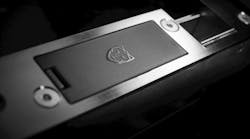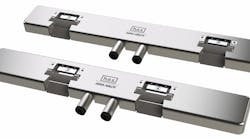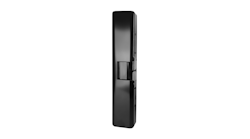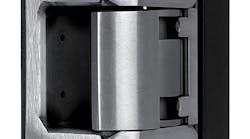Electric strikes are a foundational component of electronic access control systems.
Although there are many definitions of an electric strike, for this discussion, the term “electric strike” is a frame-mounted or door-mounted electromechanical device that uses power to lock or unlock a door.
Without a doubt, the role of the electric strike has changed since the inception of electronic door controls as the range of locking products and applications where they’re required has expanded.
When installing an electric strike, it must match with:
- The door assembly or mechanical locking device that will be used with it.
- The power sources, controlling equipment and other accessories it will work with.
- The building and life-safety codes that dictate the features and operation of the electric strike.
So, the electric strike must meet code on fire-rated doors, stairwell doors and special-application doors (industrial, corrections, health care). It has to be designed for heavy traffic, heavy doors, inclement weather and other challenges that a “harsh environment” can present. Of course, the electric strike also must fit into the door or frame where it’s installed.
I have been involved in new installs as well as retrofits and upgrades, and the part where the electric strike has to fit in the frame was a recurring challenge. It always was amazing how architects managed to get this part wrong, and the installer often was the first to know there was a problem.
Although having an inventory of strikes in the van sometimes provides a solution, it’s more like trial and error than “planning.” Even under favorable conditions, installing an electric strike was rarely a “drive-by” experience, where the locking device slipped into the frame and worked like a charm.
I recall having to cut, mortise, file and drill quite a lot. It was a skill that had to be acquired on the job and mastered through experience. The installation tools you used were those of a surgeon and included many secret weapons you protected jealously from your peers. Once, I thought I was the only locksmith who knew what a Dremel tool was!
Here’s a roundup of possible products that we hope you find don’t require special tricks.
Nexkey Solo
We knew it was only a matter of time. We have a smart everything else, so a smart strike was inevitable.
Nexkey offers just such a product, a smart strike called the Solo, as part of its electronic access control system. It isn’t necessary to use a Solo to unlock a door as part of the system, because electric strikes aren’t appropriate for every opening. Nexkey’s system uses a hub that works with virtually any device, lock or otherwise, that has a dry-contact input. This includes door operators, electrified locking hardware, electromagnetic locks and even other wireless devices that use interfaces triggered by dry contacts.
Components of the system include the Solo, the Core lock cylinder and the Controller, which connects with locks and other hardware. The Nexkey app turns a phone or smartwatch into a credential and manages the system elements. The system also can be managed via a computer through the Nexkey Portal.
As for the Solo, it comes with a metal cutout template that allows installers to mark the door frame with the correct dimensions. It’s compatible with cylindrical and mortise locks that don’t have a deadbolt on wood and hollow metal doors.
Features:
- No additional hardware required
- Physical key backup
- Takes two AA 1/2-inch batteries; batteries last 18 months
- Stays secure without battery (fail-secure)
- Nonhanded
- Supports up to a 3/4-inch latch
- Static strength of 1,500 lbs.; dynamic strength of 70 ft.-lbs.
- 500,000+ cycles (Grade 1)
- 630 Satin Steel finish
- Bluetooth range up to 15 feet
- Certifications: ANSI/BHMA A156.31 Grade 1, UL 1034, UL 294
More info: www.nexkey.com
SDC HiTower Series
These locks have been around for decades. They’re unique in their design, and although they fall under the general heading of “electric strike,” they don’t have a movable latch gate in the frame side component.
I’m always happy to encounter one of these on a service call. For one, they’re well-built, and there’s a chance that any problem will be a quick fix. For another, the customer probably is desperate to get the device repaired, because few maintenance types have a clue what this device is or how to order parts or repair it. I do!
These locks are found on newer multifloor commercial buildings, which also are pleasant environments to work in.
These systems use mortise locks, which rarely break and provide positive locking, so they’re suitable for stairwells and other openings where fire code must be adhered to strictly.
HiTower locks consist of a mechanical door lock controlled by an electric actuator installed in the frame. All access control and monitoring wires are maintained in the frame, so power-transfer hinges and wires through the door aren’t required. That means that all expenses associated with power-transfer hinges are eliminated, including the costs for door wire chases that must be factory-prepared to maintain a door’s fire rating.
The models:
- Z7530, locked inside or outside, fail-safe
- Z7550, locked outside only, fail-safe
- Z7560, locked inside or outside, fail-secure
- Z7570, locked outside only, fail-secure
- ZY7550, replaces SDC modifications of discontinued manufacturer models: Falcon LM581; SARGENT 7704/7705, Corbin 9557L/2257, Russwin 7059L, Arrow 1600EW, Yale 8705, Almet-5007 and BEST 35HEW
Features:
- Two actuator sizes for standard or narrow frames
- Exclusive alignment compensation for door gaps up to 5/16 in. (8mm)
- Mechanical key retracts the latchbolt when locked
- Choice of 24VDC, 24VAC, 115VAC
- Fits standard ANSI 4-7/8-in. strike prep
- Choice of SDC lever trim/architectural finishes
- Fits 1-3/4- to 2-in. frames, actuator for 1-1/4- to 1-1/2-in. frames optional (2-in. frame required for fail-secure)
- Compatible with Schlage lever trim provided by others
- ANSI Grade 1 compliant
- UL listed for 3-hr. fire-rated doors
More info: www.sdcsecurity.com
HES 9800
ASSA ABLOY brand HES has a vast selection of electric strikes, too many to describe here adequately, but it also has an excellent online resource that provides guidance on how to evaluate the factors to determine the right electric strike for a particular application.
The HES electric strike landing page categorizes strikes based on various requirements, including mortise locks, rim exits and fire ratings.
The low-profile, surface-mounted 9800 is designed to accommodate the Adams Rite 8700, 8800 and EX88 Series Rim Exit Devices that have a starwheel or interlocking latch bolt.
All functions are performed within the one-half-inch-thick strike body, which is protected by a stainless steel cover that also conceals the mounting screws and provides an aesthetic appearance. It’s field-selectable for fail-secure or fail-safe operation and dual voltage, 12 or 24 VDC.
Features:
- Installs on aluminum, hollow metal and wood frames (wood screws not provided)
- One 1/16-in. (1.6mm) spacer plate included
- One 1/8-in. (3.2mm) spacer plate included
- Static strength: 1,500 lbs.
- Dynamic strength: 70 ft.-lbs.
- Endurance: 1 million cycles
- Nonhanded
More info: www.assaabloyesh.com
Adams Rite UltraLine 7400 Series
Adams Rite provides a range of electric strikes compatible with deadlatches, cylindrical and mortise locksets, and rim exit devices in aluminum, hollow metal and wood applications. The UltraLine 7400 Series of electric strikes is billed as the solution for preload.
Door preload is pressure exerted on a door and in turn transferred to the keeper of the electric strike through the latch. When pressure is applied to some models of electric strikes, the solenoid might not be able to release the keeper, because the pressure binds it against the latch. Even a small amount of this preload can cause problems in the functioning of some electric strikes.
Several situations might cause door preload, including:
- Stack pressure caused by the heating and cooling system.
- A misaligned strike and lockset.
- Warped wood doors and damaged or bent metal doors.
- Thick door seals or heavy weatherstripping.
A strike that doesn’t open or opens only intermittently could be showing signs of a preload problem. If preload pressure causes a strike or multiple strikes to malfunction, access and security issues arise.
The 7400 Series is designed to handle pressure and compensate for door- and frame-related preload and security problems by using jaw inserts of various sizes. The 7400 Series operates at 12, 16 and 24VDC with one solenoid.
Certifications include UL 1034, UL 294, ULC-S319, ANSI/BHMA A156.18 and ANSI/BHMA A156.31 for electric strikes and frame-mounted actuators, Grade 1.
More info: www.adamsrite.com
RCI VR165
dormakaba brand RCI electric strikes are available in fail-safe and fail-secure modes. You can find the correct RCI electronic strike to fit your project through the company’s Cross Reference Tool.
The VR165 vertical rod strike by RCI is designed for use with vertical-rod exit devices that have a roller latch.
This surface-mounted strike accommodates a five-eighths inch roller latch. The heavy-duty VR165 is made of high-grade stainless steel. The conventional keeper design (one moving part) promotes even load distribution. To prevent vibration manipulation, the VR165 has a horizontal solenoid. Lockdown tabs provide a secure mount with hex socket head cap screws for added support and tamper resistance.
Features:
- Up to 1/4-in. (6.4mm) adjustment to compensate for door and frame misalignments
- Door-stop adjustment for different rail thicknesses
- Nonhanded
- Plug-in wire connector
- 0.450 amps field-selectable 12/24VDC and 12-24VAC (Max at 12VDC)
- 1,500 lbs. static; 70 ft.-lbs. dynamic
- 250,000 cycles
- Fail-secure
More info: www.dormakaba.com
ROFU 2400 Kit
The 2400 Kit is a universal, burglary-resistant electric strike that’s compatible with a wide range of cylindrical locksets. The kit includes two faceplates and is dual voltage and field-reversible between fail-safe and fail-secure.
The strike also is aimed for use with narrow-stile aluminum storefront latch locks. One-inch and 2-inch lip extensions are available.
Features:
- Faceplates: 1-7/16 in. x 7-15/16 in. (wood frames), 1-1/4 in. x 7-7/8 in. (ANSI)
- UL listed
- Stainless steel finish
More info: www.rofu.com
BEA Universal Cylindrical Strike
The Universal Cylindrical Strike provides controlled access and security where code compliance and safety are paramount. It has a conventional keeper design, which promotes even-load distribution in the event of a forced entry.
Three modular faceplates fit the most common door types: hollow metal, aluminum and wood.
Features:
- UL 294 listed
- Reinforced housing reduces twisting on imperfect frames
- Up to 1,500 lbs. of static strength
- Fail-safe, Fail-secure
12 VDC, 24 VDC, 12–24 VAC
More info: https://us.beasensors.com
Trine 4100 Series
Trine is a legendary manufacturer of electric strikes, and it has an extensive roster of products and patents.
Trine specialty products are the 4100DB and 4100CDBM with a full 3-3/16-inch cavity height, which is intended to accept the mortise lock bolt and a 1-inch throw deadbolt combination. These strikes are intended for high-traffic institutional applications, and they have an optional finish that resists surface abrasion.
Another specialized product is the 4100DBDL, which has two independently controlled latches for a mortise lock and deadbolt combination. This product was designed for regular access control through just a mortise lock.
If the occupant of the room has to have privacy, they can extend the deadbolt. If an emergency occurs where the occupant requires assistance, the lock can be programmed to unlock top and bottom latches, so emergency personnel has immediate access. The deadbolt, if kept extended, won’t be recaptured, so for the duration of the emergency, the door can be held open.
This can be used for dormitories, laboratories, hospital rooms and public bathrooms, among other locations. This product includes four face plates to cover most locksets.
Features:
- Grade 1 electric strike: heavy-duty construction, 1 million+ life cycles, 3,250 lbs. holding force
- 1-3/8 in. backset
- 0.240 amps at 12DC
- Warnok Hershey recognized for UL10C, fire tests of door assemblies
- UL 1034 burglary-resistant
- UL294 (6th Edition) listed
More info: www.trineonline.com
Tim O’Leary is an experienced security consultant and a regular contributor to Locksmith Ledger.






